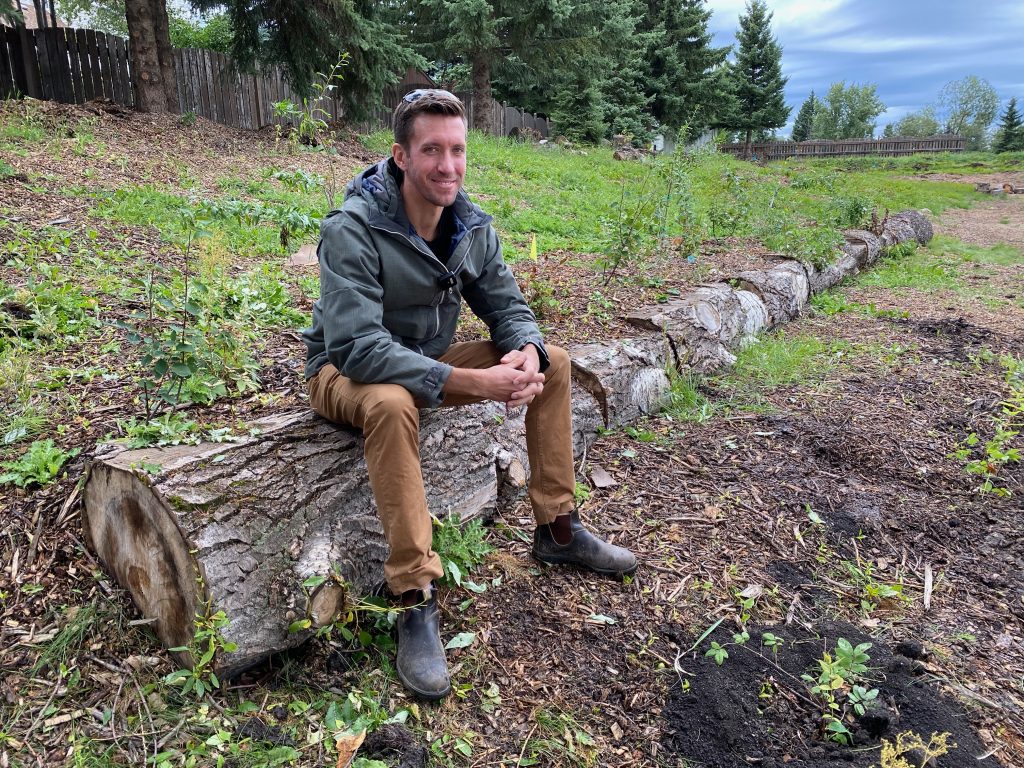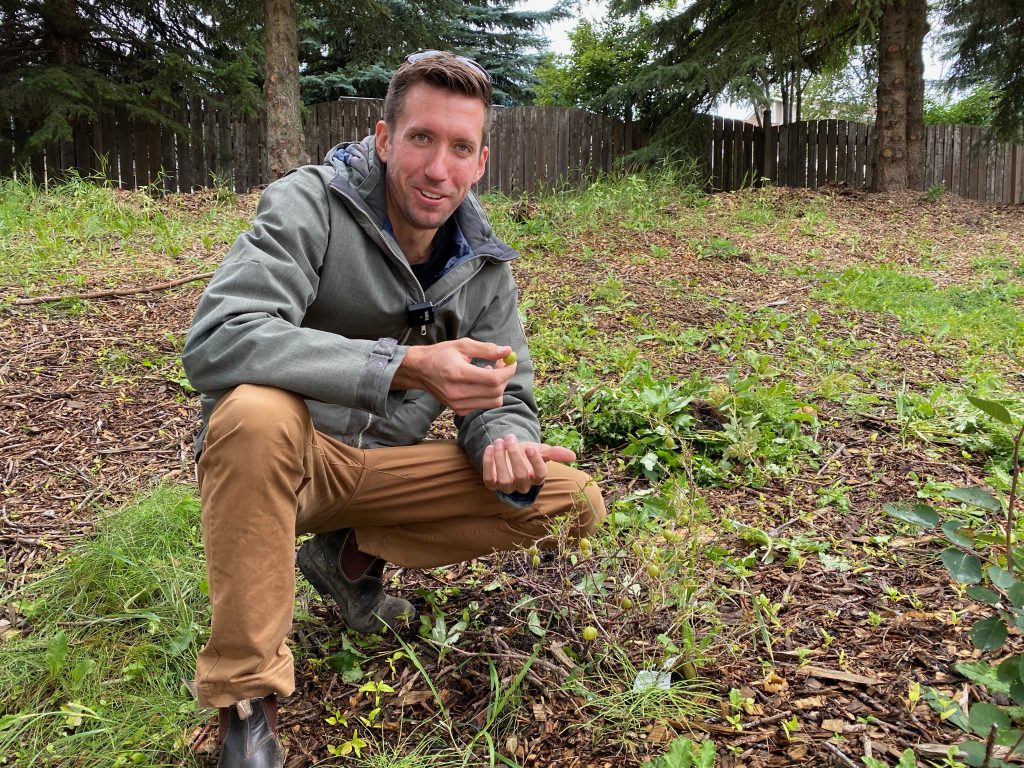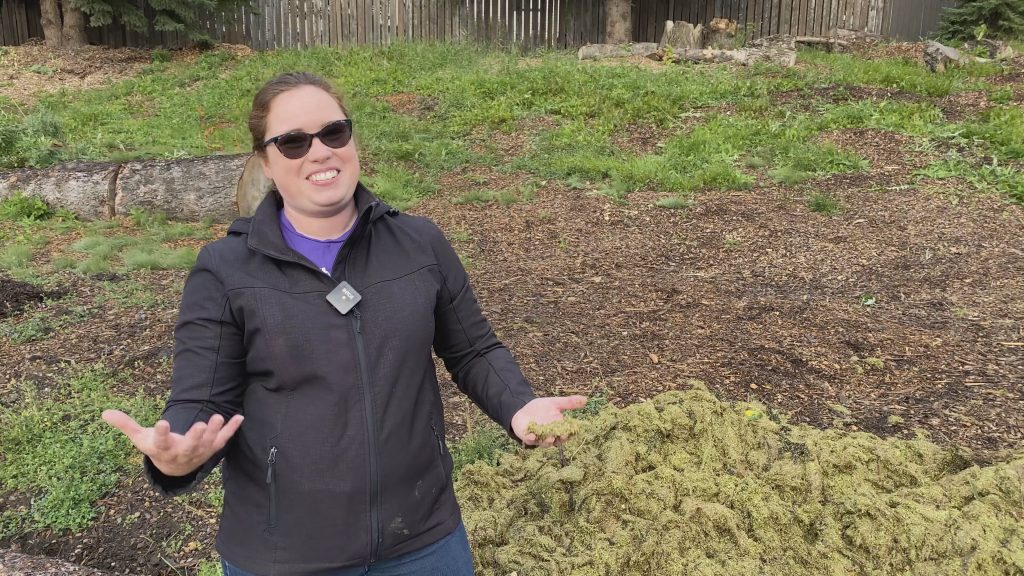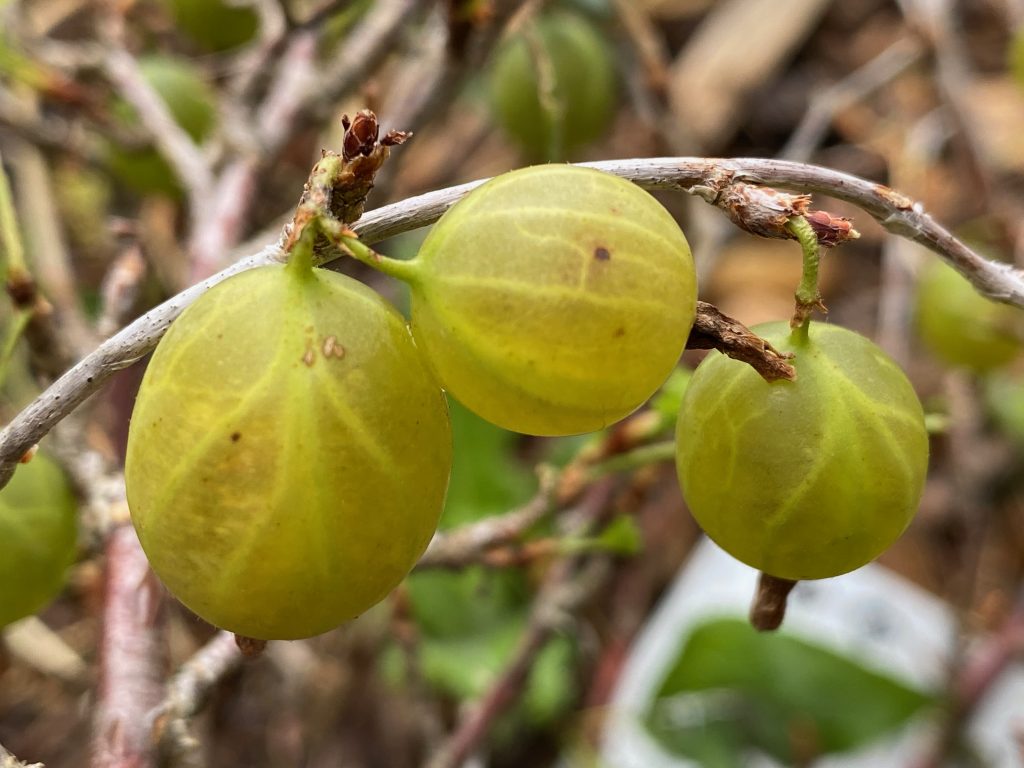By David Dodge and Kay Rollans
In his final manuscript Wild Fruits, Henry David Thoreau says that “[t]he value of these wild fruits is not in the mere possession or eating of them, but in the sight and enjoyment of them.”
Permaculturist Kenton Zerbin seems to embrace Thoreau’s appreciation of nature, especially when he looks at a human-created landscape such as the interminable lawn.
Zerbin enjoys rehabilitating landscapes and creating connections between people, their food, and nature.


He’s in the middle of taking the mundane, lawn-based landscape at Grace Community Church in St. Albert and transforming it into a food forest: a beautiful, edible landscape.
The church land is sloped, hard to mow, and not used for much. In this last regard, it looks—or, rather, looked—like so many other church property landscapes. But it is also in this last regard that Grace Community Church distinguished itself.
It was the pastor, Zerbin says, who piped in and said: “How about we make this a food forest and edible landscape? And I know just the guy.”
With support from the City of St. Albert and the surrounding community, Zerbin set out to rehabilitate and repurpose the church lawn.
A walk in the food forest
“This landscape has been optimized for sun, water, and people,” Zerbin told me on a tour of the food forest in its early stages.
“It follows the curve of this land,” he said, showing me the L-shaped property. “There’s going to be a fireplace right here in this little flat zone with a bunch of stumps you can sit on. Parents can sit there and watch their kids run down the whole property as they pick and eat food.”
Where the slope curves around the corner, Zerbin is building a natural auditorium for community events and programs. The auditorium is embedded into the edible landscape.
“The top, where you see these flags, that’s all fruit trees. We’re going to have cherries. We’re going to have more Saskatoons. It’s going to be great. And then on the lower area, we’re going to have a raised garden bed that comes out of the hillside.”
And then there are the “terraces”: landscaping designed specifically to retain and distribute rainwater to reduce the need to water plants during dry spells.

“We’ve used logs given to us by arborists, put them on contour so that water is captured behind them, and that water then goes to fruit trees!” says Zerbin, with an enthusiasm that cannot be recreated with punctuation. (Check out our video to see what I mean.)
Everything Zerbin plants is edible or in some way useful, either to humans or to the landscape itself. He also focuses particularly on native species, which naturally thrive with very little attention.
His enthusiasm only swelled as he began pointing out the variety of fruiting plants on the terraces: gooseberries, saskatoons, goji berries, beaked hazelnuts. “And that’s just the first row,” he said. “The row we passed that was lower down is all haskaps—hundreds of them.”
Sea buckthorn is another favourite plant to use in his Alberta landscapes. “[It] is also a very hardy, nitrogen-fixing tree, and it has a bright orange berry,” Zerbin explained. “The leaves can be used for tea. The fruit can be eaten fresh, it can be dried into leather, it can be frozen and added to your smoothies and it can be used as a buffer species.”

Growing food, growing community
The church’s edible landscape will be publicly accessible, and a local community group has formed to support the project.
“Just yesterday, we were here with the new community group that just came on out and we planted over 50 haskap bushes to add to the project,” says Zerbin. It’s truly a “growing” project.
“This project now has over 150 fruit trees and shrubs, and it’s all free for community, installed by community with city support,” says Zerbin.

Emily Brady, one of the community volunteers, is a local librarian working for St. Albert Public Library. “I got involved in this project through the St. Albert seed library. We started the seed library this spring and we needed community partners who were interested in growing plants and being part of a community of sharing,” she says.
Brady’s involvement in the garden isn’t just work related; it’s also personal. “I live just down the street and it’s in my neighborhood. We’re interested in gardening and learning about permaculture and being a part of a broader network of people here in St. Albert.”
Food forests are an ideal and accessible way for people to learn about and be part of the process of growing food. Unlike conventional gardens, Zerbin says the project allows people to “connect with their food” in a way that is not to laborious.
“A lot of work that goes into making a garden or a monoculture agricultural system. But trees grow themselves,” says Kenton. “Yes, you need to put the energy in to plant them. Yes, you’ve got to make sure they stay alive. But then after that, year after year after year, they keep producing food for you.”

Food forests, part of a sustainable landscape
Zerbin says we need to not only readdress where our food comes from, but examine our basic relationship to the land. “How do we ensure that we are net positive, not just sustainable?…One of the ways we do that is we use species that are hard-working, capture carbon, store it in organic sources, produce our food locally.”
Trees, Zerbin suggests, are an essential part of this process.
“Trees are our true weapon against climate change,” says Zerbin. “They are amazing, absolutely amazing at sequestering carbon and they do it all the time and meanwhile provide so many other ecosystem services and products for us.”
And yet, Zerbin says, we’ve denuded our planet of trees.
“They used to be gigantic bodies of thermal mass and water and they stopped the sun from hitting our soils and baking them,” said Zerbin. “To stay cool, trees evaporate their water—evapotranspiration—and cool the air around them effectively.”
Indeed, anyone with a south- or west- facing home knows that a broadleaf tree is the best air conditioner you could have, shading our homes in summer and allowing the sun’s thermal energy through to passively heat them in winter.
For Zerbin, the answer to some of the most urgent of the world’s woes isn’t just trees, but fruiting trees. All plants are nature’s climate warriors, but food is at the heart of reimagining a more sustainable relationship to the earth.
But in this part of the world, it is still relatively uncommon to focus on trees as major food producers. “This is an untapped resource of how we use the sun’s energy and convert it into sugars for humans.”

